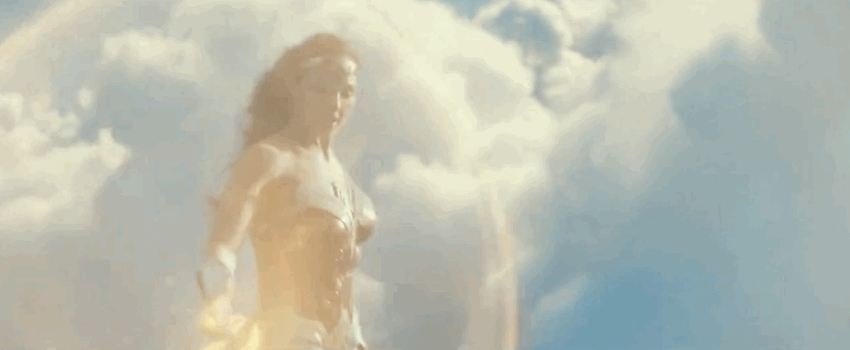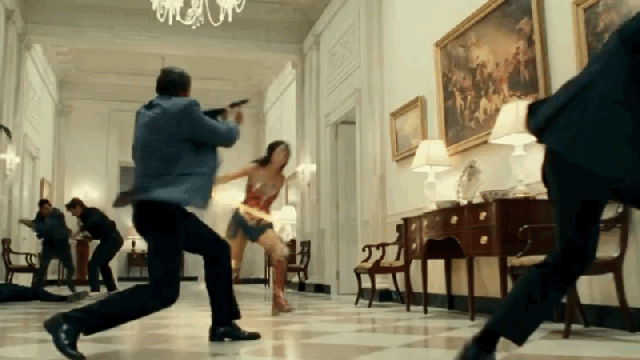In Warner Bros.’ Wonder Woman 1984, princess Diana of Themyscira whips out a bevy of new, magical tricks to aid in her fight to save the world. She does battle with both Max Lord and Cheetah, two villains meant to embody all wanton greed and consumption that defined the decade. Though both her foes are armed in their own unique ways, Diana decides to rely on a set of tried and true Amazonian classics.
While Diana’s golden armour and her ricocheting diadem are both cool as hell, out of all the Amazon’s toys, it’s the Lasso of Truth that inarguably steals the show. It’s spotlighted in almost each and every single one of her fight sequences, and factors into a moment that embodies her growth over the course of the film.
[referenced id=”1660751″ url=”https://gizmodo.com.au/2020/12/wonder-woman-1984-has-one-great-thing-going-for-it/” thumb=”https://gizmodo.com.au/wp-content/uploads/2020/12/29/ct5bw8ryikg71g1yqkto-300×168.jpg” title=”Wonder Woman 1984 Has One Great Thing Going for It” excerpt=”Wonder Woman 1984 has been quite the lightning rod since its release. On the one hand, there’s the epic scope, complex romance, rousing score, and positive messages. It also has an incredible cast including Gal Gadot, Kirsten Wiig, Chris Pine, and Pedro Pascal. On the other hand, some have criticised…”]

Despite witnessing the rapid evolution of humanity’s machines of war between the events of Patty Jenkins’ first Wonder Woman movie and 1984, Diana swings into the story armed only with her classic armour, her headgear, and her trusty lasso. Of course, Diana’s centuries of wisdom and training still make her more formidable than any mere mortal. Before 1984‘s plot properly kicks in, however, we’re reintroduced to a woman who has taken up a new life in Washington D.C. She works as an anthropologist in her civilian guise when she isn’t zooming around the city busting crime in her Amazonian battle gear.
When faced with a squad of armed thieves attempting to rob a mall, Diana swings through on her lasso in one of the film’s more whimsical scenes. It plays to much younger audiences and gives you a sense that she’s come to see the lasso as a useful means of transportation, at least indoors. With her whole suite of powers activated, there are few objects that Diana wouldn’t be able to wield effectively as a weapon, but 1984 presses on this idea as the plot gradually begins to sap Diana of her god-given abilities. She’s increasingly forced to need a mysteriously-resurrected Steve Trevor in moments where she’s in danger.
One of the more interesting things about the story is how it grapples with the previous film establishing that Diana is actually a demigod in addition to being an immortal Amazon. At this point in her life, Diana’s familiar enough with the nature of her heritage to understand that she’s far, far more physically powerful than most people she encounters, and you see that she fights with restraint in order to avoid hurting her enemies too badly. But by draining Diana of her powers, 1984 puts Diana in a position where she has to use her wits, an idea that the movie isn’t exactly sure how to handle.
[referenced id=”1658580″ url=”https://gizmodo.com.au/2020/12/wonder-woman-1984s-powerful-message-soars-above-its-superheroic-excess/” thumb=”https://gizmodo.com.au/wp-content/uploads/2020/12/16/uvxuqngi9lxxngap8ot6-e1608076116147-300×152.jpg” title=”Wonder Woman 1984’s Powerful Message Soars Above Its Superheroic Excess” excerpt=”The first 10 minutes of Wonder Woman 1984 moved me to tears. Part of it was the long-awaited return to Themyscira, seeing a young Diana (Lilly Aspell) battle her fellow Amazons in an epic action scene set to an incredible new score by Hans Zimmer. But another part was just…”]
The moment someone first manages to shoot and wound Diana while fighting inside the White House, she realises that charging the men the way she normally would won’t exactly work in the situation. After flinging her diadem at them, she shifts to doing something different with the lasso; Though the scene was featured extensively in Wonder Woman 1984‘s promos, it’s still decidedly wild to watch Wonder Woman spinning the Lasso of Truth to create a shield of air that not only blocks bullets but also can be pushed as a projectile to knock targets over like bowling pins.
The White House fight is arguably the film’s strongest action sequence because of the way it draws your attention to Diana’s grace, strength, and ingenuity, while also giving Gal Gadot’s stunt double(s) a chance to show off their skills. Otherworldly though she may be, hand-to-hand combat still showcases the character’s strength in the most impactful way. The lasso, in particular, shines brightest — both literally and metaphorically — in this scene, as it’s animated in a way that makes you understand it as an extension of Diana’s physical presence and her adaptability in combat. In a very strange way, the Lasso of Truth also often ends up feeling somewhat more expressive than Gadot herself, whose approach to Diana this time around feels decidedly staider and more reserved, perhaps because of the dread that looms over her as the movie builds to its final act.
That’s not to say the use of the famous tool worked all the time. In the optically-suspect sequence in which Diana saves a group of Arab children from an oncoming tank, it becomes a lowkey bit of biting commentary about how some of the script’s social ideas could have used more eyeballs in the pre-production stages. Instead of looking like the heroic moment it was likely meant to be, the janky imagery of the lasso — and Diana swinging in à la Spider-Man — only magnified the scene’s already messy political subtext.

The audience is meant to empathise with Diana’s pain as she comes to the conclusion that the only way to restore her powers is to let Steve’s spirit pass back into the afterlife, and to the movie and Gadot’s credit, Diana’s re-powered sprint down Pennsylvania avenue is also the beginning of a choice sequence that transcends its cheesiness. Wonder Woman 1984 touches on the different ways that Diana’s been able to fly in various DC media over the decades, and while the nod to her invisible jet is cute, it’s her self-propelled flight that really ends up stealing the show…kind of.
As a grief-stricken Diana flings herself into the sky with the Lasso of Truth and then flings herself even higher into the atmosphere by hitching a ride to a passing commercial plane, it briefly seems as if Diana intends to jettison herself out of the atmosphere in an uncharacteristic fit of fatalism. But instead, the hero steadies herself miles in the air and thinks back on how Steve spoke about the experience of flying planes. It’s here she whips out her lasso and spins is aggressively to use the resistance it creates to propel herself forward, effectively granting her the ability to fly because of her sheer strength.
While she eventually is able to keep herself suspended mid-air without it, and Diana’s self-propelled flight initially seems silly (because it is), its silliness doesn’t preclude it from being one of 1984‘s more inventive uses of a controversial element of the Wonder Woman’s power set — something that sets her apart from her DC counterparts. Even though the plot briefly loses its grip on the lasso’s significance when Diana suddenly decides to put on her winged armour, which kind of nullifies the significance of her learning to fly on her own steam, the movie manages to gain back its focus when she uses the rope as a kind of auxiliary cord that allows her to beam a message of hope and wonder across the entire globe.
The Lasso of Truth doesn’t in any way save Wonder Woman 1984 from its many glaring narrative issues, but it is an excellent example of how ridiculous elements of comic book characters’ identities really shouldn’t be tossed aside simply because they read funny on paper.
[referenced id=”1660926″ url=”https://gizmodo.com.au/2020/12/gal-gadots-wonder-woman-is-a-trash-friend/” thumb=”https://gizmodo.com.au/wp-content/uploads/2020/12/30/ehdt5oykomyv488c5b0f-300×169.jpg” title=”Gal Gadot’s Wonder Woman Is a Trash Friend” excerpt=”Wonder Woman is supposed to be the best of women. This isn’t me starry-eyed about a fictional character and forcing her to be a defender and icon. William Moulton Marston created her to be the best of women. The character, besides being heavily rooted in Marston’s love of bondage, was…”]For more, make sure you’re following us on our Instagram @io9dotcom.
